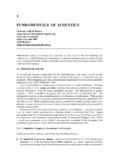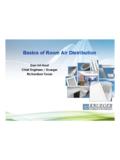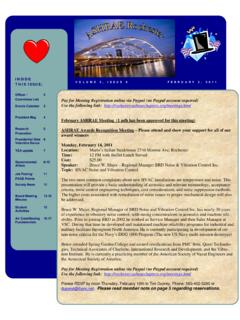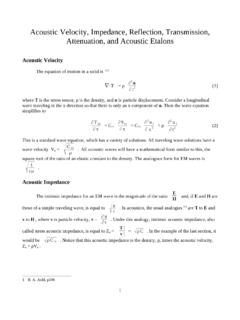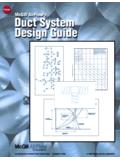Transcription of September 17-20, 2018 (Monday – Thursday)
1 GEAR DYNAMICS AND GEAR NOISE. SHORT COURSE. to be held at Fawcett Center The Ohio State University Campus Columbus, Ohio 43210, USA. Taught by Dr. Donald R. Houser, Dr. Rajendra Singh, Dr. Ahmet Kahraman, and Dr. David Talbot NVH & Gear Education September 17-20, 2018. (Monday Thursday). WHO SHOULD ATTEND. GEAR DYNAMICS AND GEAR NOISE COURSE. The course is of particular interest to engineers and Gear Whine and Rattle technicians involved in the analysis, manufacture, design Transmission Error - The Main Source specification, or utilization of simple and complex gear systems.
2 Industries that find this course helpful include the Measurements for Gear Noise Diagnosis automotive, transportation, wind-energy, process machinery, Noise, Vibration and Harshness Issues aircraft, appliance, general manufacturing, and all gear Gear Tooth, Shaft & Bearing Dynamics manufacturers. Profile Design, and Manufacturing Issues The course material is covered in such a way that the Transmission Paths and Housing Acoustics fundamentals of gearing, gear dynamics, noise analysis and All Types of Gears including Hypoids measurements are covered first.
3 This makes the course Noise and Vibration Reduction Techniques appropriate to the gear designer with minimal knowledge of Laboratory Demonstrations noise and vibration analysis as well as to the noise specialist Demo of GearLab Computer Software with little knowledge of gears. Design Guidelines & Optimization PURPOSE COURSE LECTURES (FIRST 3 DAYS). The purpose of this unique short course is to provide a A popular feature of this course is the interspersing of better understanding of the mechanisms of gear noise demonstrations with lectures.
4 The extensive measurement and generation, methods by which gear noise is measured and computer software capabilities of the Gear and Power predicted, and techniques employed in gear noise and Transmission Research Laboratory allow us to do this in a vibration reduction. Over the past 39 years more than 2050 simple and non-commercial manner. engineers and technicians from over 375 companies have On the first day, the lecturers discuss why even perfect attended the Gear Noise Short Course. gears make noise. They present in both qualitative and quantitative terms how gear design parameters and manufacturing errors affect noise.
5 The concept of gear transmission error, one of the major contributors to gear noise, COURSE INSTRUCTORS. is developed, and methods of predicting transmission errors from design and manufacturing data are presented. Dr. Donald R. Houser Participants get a clear physical insight into the problems they (Emeritus Professor and Founder of OSU GearLab). face and how they may apply course knowledge to help solve their gear noise problems. Dr. Rajendra Singh On the second day, lecturers concentrate on gear system (Emeritus Professor and Director of OSU Acoustics &.)
6 Dynamics and acoustics, dynamics of parallel axis and Dynamics Laboratory). planetary gears, transmission error calculations and measurements. The role of spacing error will be discussed as Dr. Ahmet Kahraman well. (Professor and Director of OSU Gear and Power Transmission Research Laboratory). The third day's lectures briefly discuss the sources and simulation models of gear rattle as well as spending several Dr. David Talbot hours in the case history workshop. (Research Assistant Professor). Please go to for bios.
7 CASE HISTORY WORKSHOP ON DAY 3. This novel approach to discussing "real life" gear noise and dynamics problems has been used in this course since its GENERAL INFORMATION. inception. The workshop, which has been lauded by past attendees for its practical flavor, takes place on the third day Registration: of the course. The purpose of this workshop is to allow the 1. Advance registration is required and should be completed course instructors and participants to interact and to discuss as soon as possible. Payment details (via major credit gear noise and dynamics case histories presented by course card) are posted on the web site.
8 Applicants are usually attendees. They are asked to present a brief synopsis of accepted on a first come, first served basis to the limit of problems they have encountered or of a procedure they have the course. However, the organizers reserve the right to used for gear noise analysis and reduction. Possible limit admission to the best qualified. approaches to solve each problem will be discussed. 2. Course payment must be completed along with or immediately after the registration to confirm the attendance. 3. The latest agenda, nearby hotels, parking, airport LABORATORY DEMONSTRATIONS ON DAY 2 transportation, and other relevant information are posted on the web page ( ).
9 Throughout the course, laboratory and computer software demonstrations are used to illustrate gear noise measurement and analysis techniques. The facilities of the Gear and Power Contact: Transmission Research Laboratory ( ) and the Dr. Rajendra Singh (614-292-9044, or Acoustics and Dynamics Laboratory ( ) are used for registration information. for these demonstrations. Dr. Donald R. Houser (614-292-5860, or should be contacted for technical information and workshop topics. SIMULATION AND EXPERIMENTAL. METHODS SESSIONS ON DAY 4.))
10 The sessions on Day 4 will address the following topics and related simulation or experimental methods: a. Planetary gear dynamics and modulations b. Casing vibration, acoustics and system models c. Advanced gear excitation measurement d. Gear rattle and vehicle clunk case studies e. Verification and experimental validation issues See web page ( ) for more details. Agenda for Gear Dynamics & Gear Noise Short Course 2018 (subject to change). MONDAY: SEPT. 17 (DAY 1). 8:00 AM Registration 8:15 AM Introduction and overview Dr.
